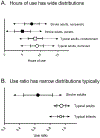Sensor Measures of Symmetry Quantify Upper Limb Movement in the Natural Environment Across the Lifespan
- PMID: 30703350
- PMCID: PMC6645783
- DOI: 10.1016/j.apmr.2019.01.004
Sensor Measures of Symmetry Quantify Upper Limb Movement in the Natural Environment Across the Lifespan
Abstract
Knowledge of upper limb activity in the natural environment is critical for evaluating the effectiveness of rehabilitation services. Wearable sensors allow efficient collection of these data and have the potential to be less burdensome than self-report measures of activity. Sensors can capture many different variables of activity and daily performance, many of which could be useful in identifying deviation from typical movement behavior or measuring outcomes from rehabilitation interventions. Although it has potential, sensor measurement is just emerging, and there is a lack of consensus regarding which variables of daily performance are valid, sensitive, specific, and useful. We propose that symmetry of full-day upper limb movement is a key variable. We describe here that symmetry is valid, robustly observed within a narrow range across the lifespan in typical development, and shows evidence of being different in populations with neuromotor impairment. Key next steps include the determination of sensitivity, specificity, minimal detectable change, and minimal clinically important change/difference. This information is needed to determine whether an individual belongs to the typical or atypical group, whether change has occurred, and whether that change is beneficial.
Keywords: Rehabilitation; Upper extremity.
Copyright © 2019 American Congress of Rehabilitation Medicine. Published by Elsevier Inc. All rights reserved.
Conflict of interest statement
The authors declare no conflicts of interest.
Figures


Similar articles
-
Assessment of upper limb use in children with typical development and neurodevelopmental disorders by inertial sensors: a systematic review.J Neuroeng Rehabil. 2018 Nov 6;15(1):94. doi: 10.1186/s12984-018-0447-y. J Neuroeng Rehabil. 2018. PMID: 30400992 Free PMC article.
-
A Method for Quantifying Upper Limb Performance in Daily Life Using Accelerometers.J Vis Exp. 2017 Apr 21;(122):55673. doi: 10.3791/55673. J Vis Exp. 2017. PMID: 28518079 Free PMC article.
-
Relationships between accelerometry and general compensatory movements of the upper limb after stroke.J Neuroeng Rehabil. 2020 Oct 20;17(1):138. doi: 10.1186/s12984-020-00773-4. J Neuroeng Rehabil. 2020. PMID: 33081783 Free PMC article. Clinical Trial.
-
Identifying compensatory movement patterns in the upper extremity using a wearable sensor system.Physiol Meas. 2017 Nov 30;38(12):2222-2234. doi: 10.1088/1361-6579/aa9835. Physiol Meas. 2017. PMID: 29099724
-
Systematic Review on Kinematic Assessments of Upper Limb Movements After Stroke.Stroke. 2019 Mar;50(3):718-727. doi: 10.1161/STROKEAHA.118.023531. Stroke. 2019. PMID: 30776997
Cited by
-
Day-to-Day Variability of Walking Performance Measures in Individuals Poststroke and Individuals With Parkinson Disease.J Neurol Phys Ther. 2020 Oct;44(4):241-247. doi: 10.1097/NPT.0000000000000327. J Neurol Phys Ther. 2020. PMID: 32769671 Free PMC article.
-
Daily Life Upper Limb Activity for Patients with Match and Mismatch between Observed Function and Perceived Activity in the Chronic Phase Post Stroke.Sensors (Basel). 2021 Sep 2;21(17):5917. doi: 10.3390/s21175917. Sensors (Basel). 2021. PMID: 34502808 Free PMC article.
-
Actigraphic Measurement of the Upper Limbs for the Prediction of Ischemic Stroke Prognosis: An Observational Study.Sensors (Basel). 2021 Apr 2;21(7):2479. doi: 10.3390/s21072479. Sensors (Basel). 2021. PMID: 33918503 Free PMC article.
-
A Large Harmonized Upper and Lower Limb Accelerometry Dataset: A Resource for Rehabilitation Scientists.medRxiv [Preprint]. 2024 Aug 16:2024.08.15.24312066. doi: 10.1101/2024.08.15.24312066. medRxiv. 2024. PMID: 39185533 Free PMC article. Preprint.
-
Quantifying the effects of sleep on sensor-derived variables from upper limb accelerometry in people with and without upper limb impairment.J Neuroeng Rehabil. 2024 May 28;21(1):86. doi: 10.1186/s12984-024-01384-z. J Neuroeng Rehabil. 2024. PMID: 38807245 Free PMC article.
References
-
- World Health Organization. International Classification of Functioning, Disability and Health (ICF). http://www.who.int/classifications/icf/en/. Accessed 09/26/18
Publication types
MeSH terms
Grants and funding
LinkOut - more resources
Full Text Sources
Medical

